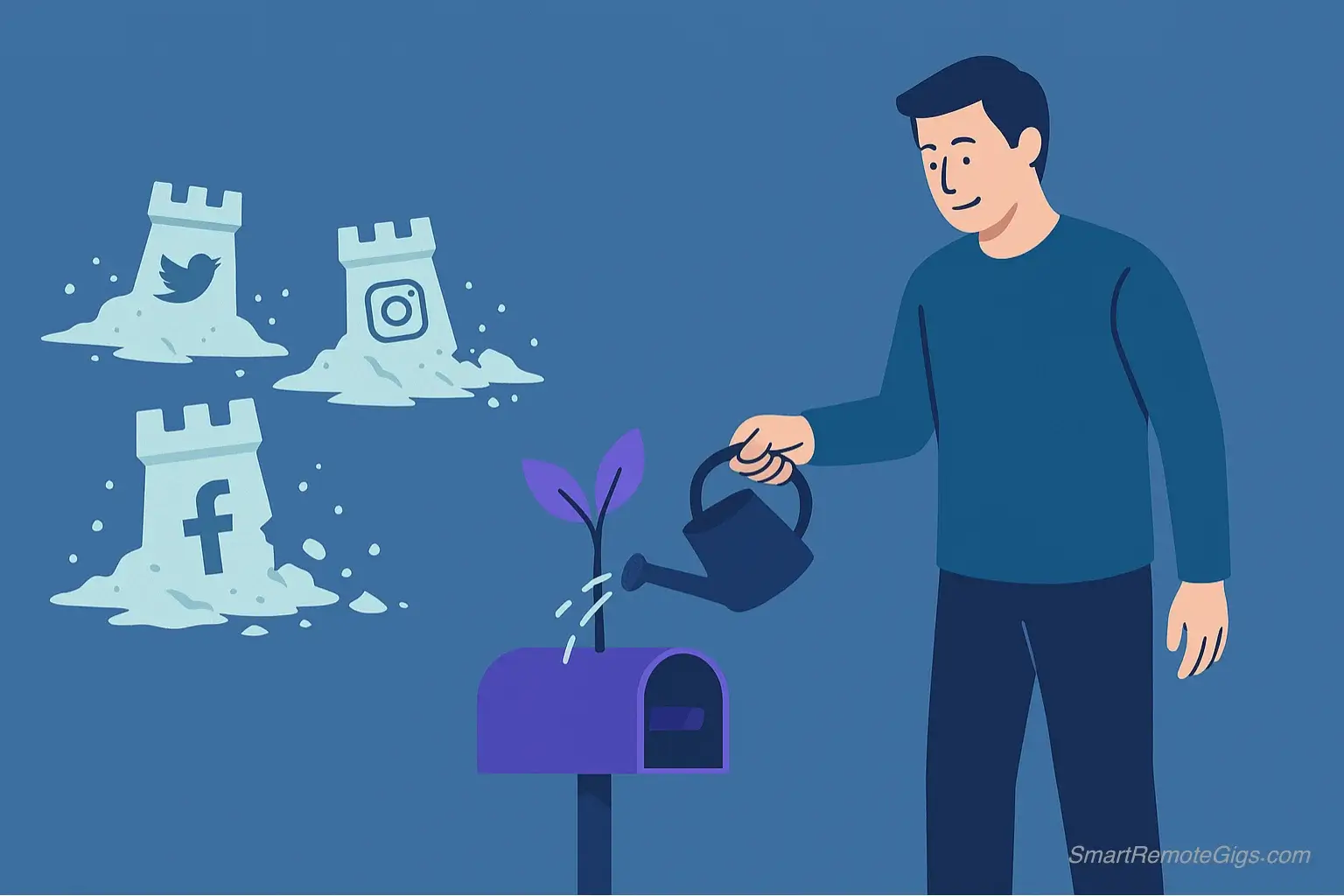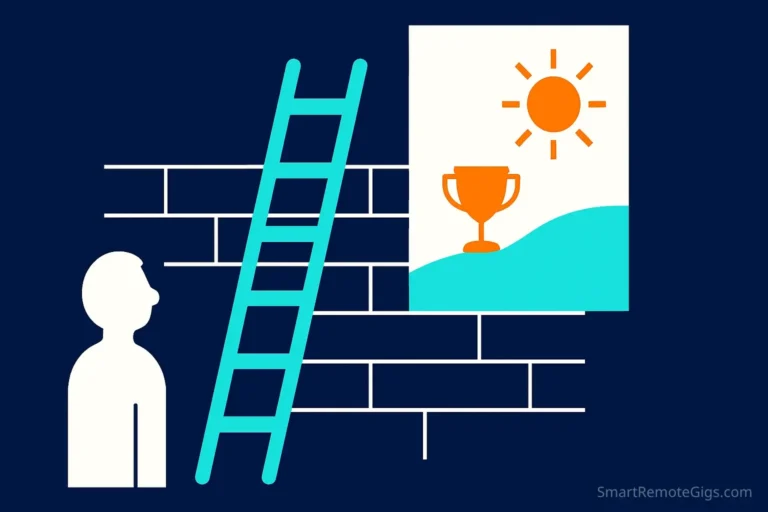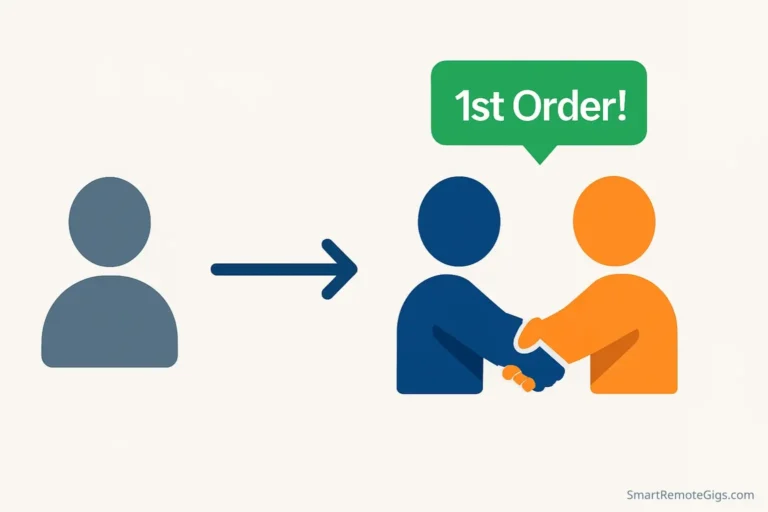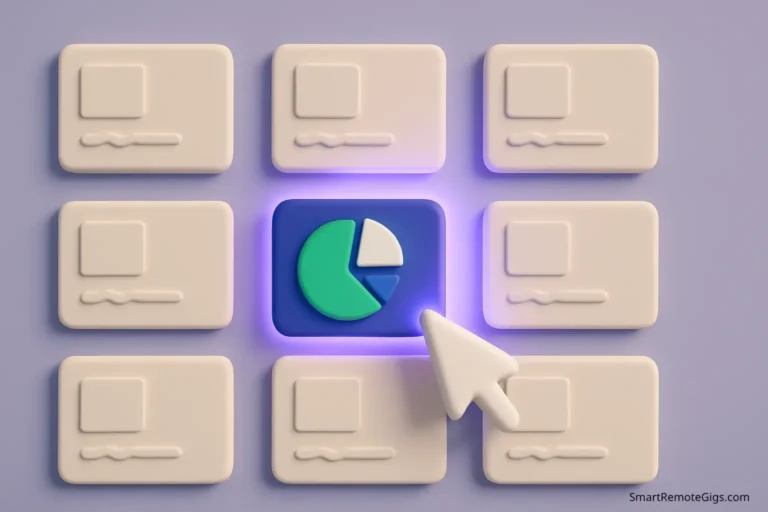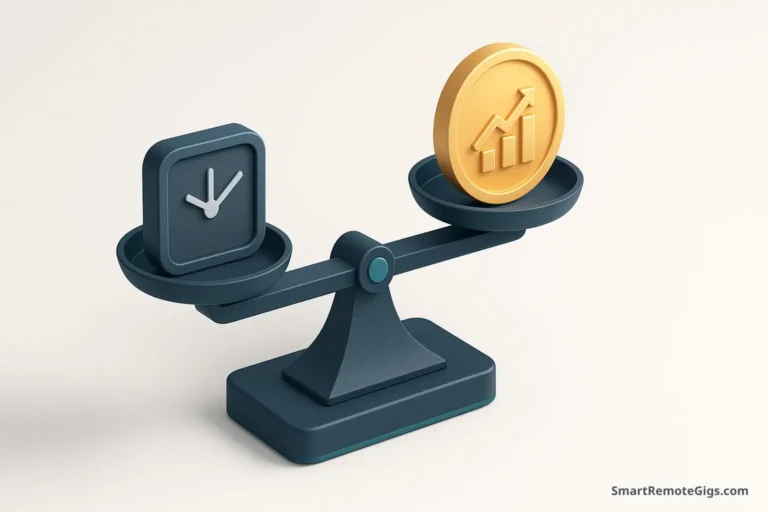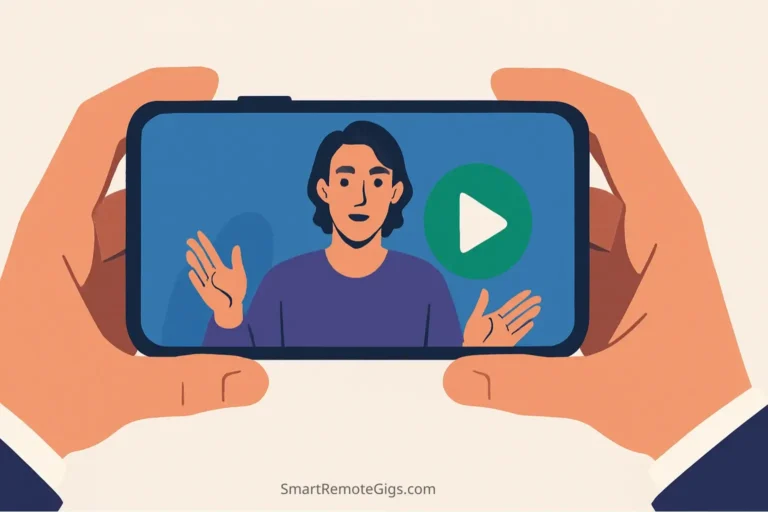Social media is rented land. Your email list is property you own.
That single truth should fundamentally change how you think about building your freelance business. While algorithms control who sees your Instagram posts and LinkedIn updates, your email newsletter lands directly in your subscribers’ inboxes. No middleman. No platform changes that can destroy your reach overnight.
A newsletter is the single best way to build a direct relationship with your audience. It’s your direct line to potential clients, a platform to showcase your expertise, and eventually, a powerful revenue stream. Whether you’re a graphic designer, copywriter, web developer, or consultant, starting an email newsletter positions you as the go-to expert in your field.
The best part? You don’t need thousands of followers to start. You don’t need perfect content or a massive marketing budget. You just need to begin.
The 7-Step Freelancer Newsletter Launch Plan
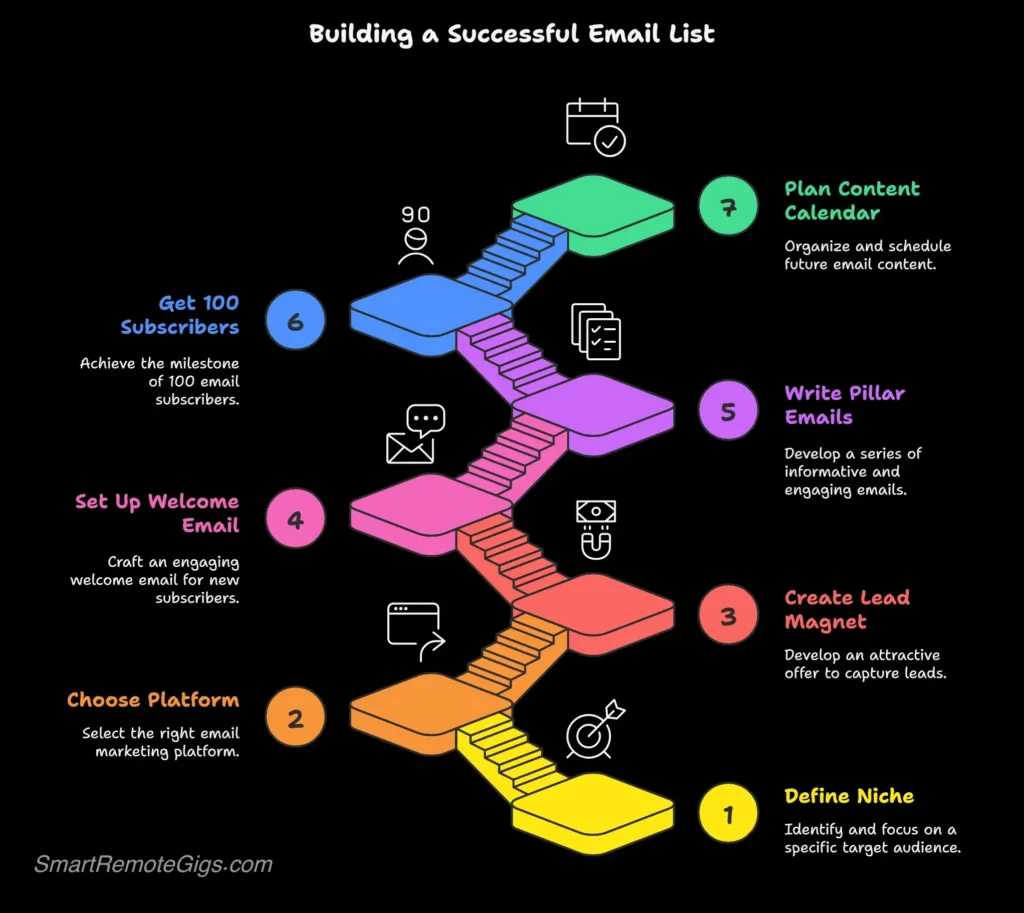
Starting a newsletter can feel overwhelming, but breaking it down into clear steps makes it manageable. Here’s your roadmap to launch a newsletter that builds your freelance business and creates genuine value for your readers.
Step 1: Define Your Niche & Goal (The “Who” and “Why”)
Before you choose a platform or write a single word, you need crystal clarity on two things: who you’re serving and why they should care.
Define Your “Who”: Your newsletter audience should align with your ideal freelance clients or the community you want to build. Ask yourself:
- What type of business owners or professionals do I want to work with?
- What challenges do they face that I can help solve?
- Where do they currently go for information in my field?
For example: “I help small business owners understand digital marketing without the jargon” or “I teach fellow designers how to price their work and find better clients.”
Clarify Your “Why”: Your newsletter needs a clear value proposition. What will readers get that they can’t find elsewhere? Your unique angle might be:
- Behind-the-scenes insights: Share what you learn from client projects
- Curated expertise: Filter industry news through your professional lens
- Practical tutorials: Break down complex processes into actionable steps
- Personal journey: Document your freelance growth and lessons learned
Write a one-sentence mission statement: “My newsletter helps [target audience] achieve [specific outcome] by providing [unique value].”
Step 2: Choose Your Platform (Substack vs. Ghost vs. ConvertKit)
The platform you choose will be your newsletter’s home for potentially years to come. Here’s a comparison of the three most popular options for freelancers:
| Platform | Best For | Monthly Cost | Key Features | Pros | Cons |
|---|---|---|---|---|---|
| Substack | Content creators who want simplicity | Free (5% fee on paid subscriptions) | Built-in discovery, easy monetization, simple editor | Zero learning curve, built-in audience potential | Limited design customization, takes percentage of revenue |
| Ghost | Professional publishers who want control | $9/month | Full website + newsletter, custom design, membership features | Complete control, professional appearance, no revenue sharing | Steeper learning curve, requires more setup |
| ConvertKit | Business-focused creators building funnels | $29/month | Advanced automation, landing pages, detailed analytics | Powerful marketing features, excellent deliverability | More expensive, can be overwhelming for beginners |
For most freelancers starting out, Substack is the clear winner. It removes every technical barrier and lets you focus on writing. You can always migrate later if you outgrow it.
Step 3: Create a Simple “Lead Magnet” (A Compelling Reason to Subscribe)
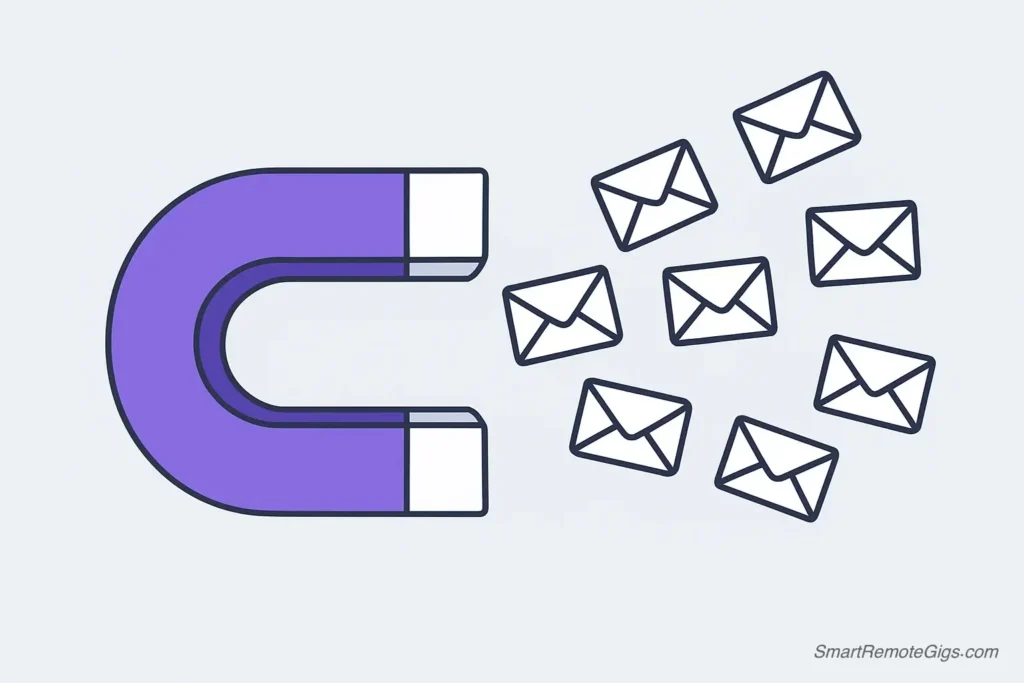
People need a reason to give you their email address. A lead magnet is a valuable free resource you offer in exchange for a subscription.
Effective Lead Magnets for Freelancers:
- Checklists: “The 15-Point Website Launch Checklist Every Business Needs”
- Templates: “5 Email Templates That Get Clients to Pay Invoices Faster”
- Mini-courses: “3-Day Email Course: How to Price Your Services With Confidence”
- Resource lists: “The Ultimate Toolkit: 25 Free Tools Every [Your Specialty] Should Know”
- Case studies: “How I Helped a Startup Increase Conversions by 200% (Full Breakdown)”
Keep it simple for your first lead magnet. A well-designed PDF checklist often outperforms elaborate courses. The key is making it immediately useful and specific to your audience’s pain points.
Pro tip: Your lead magnet should naturally lead to your services. If you’re a copywriter, offer email templates. If you’re a designer, create a brand checklist. This ensures you’re attracting potential clients, not just freebie seekers.
Step 4: Set Up Your Automated Welcome Email (The Most Important Email You’ll Write)
Your welcome email sets the tone for your entire relationship with subscribers. It’s delivered when people are most engaged – right after they sign up – so make it count.
Essential Elements of a Great Welcome Email:
- Personal introduction: Who are you and why should they trust you?
- Deliver the promised lead magnet immediately: Don’t make them wait
- Set expectations: When will they hear from you and what can they expect?
- Give them a quick win: Share one valuable tip they can implement today
- Invite engagement: Ask a question or encourage them to reply
Sample Welcome Email Structure:
Subject: Your [Lead Magnet] is here (plus what to expect)
Hi [First Name],
Welcome! I'm thrilled you've joined [Newsletter Name].
First things first – here's your [Lead Magnet Name]: [Link]
I'm [Your Name], and I've been [brief credentials/experience]. I started this newsletter because [personal reason that connects to their needs].
Every [frequency], I share [what you share] to help you [outcome they want]. No fluff, no endless sales pitches – just practical insights you can use immediately.
Here's a quick tip while you're here: [One actionable tip]
I'd love to know: what's your biggest challenge with [your topic] right now? Hit reply and let me know – I read every email.
Talk soon,
[Your Name]
P.S. Make sure to add my email ([your email]) to your contacts so my newsletters don't end up in spam!
Step 5: Write Your First 3 “Pillar” Emails (To Deliver Immediate Value)
Before you start promoting your newsletter, have your first three emails ready to go. These “pillar” emails should cover your core expertise and give new subscribers immediate value.
Choose topics that:
- Address common pain points in your field
- Showcase different aspects of your expertise
- Can be implemented quickly by readers
- Position you as a helpful expert, not a sales person
Example Pillar Email Topics for Different Freelancers:
For Web Designers:
- “3 Website Mistakes That Kill Conversions (And How to Fix Them)”
- “The 5-Minute Site Speed Audit Every Business Owner Should Do”
- “Why Your Website Visitors Leave (And the Psychology Fix)”
For Copywriters:
- “The Email Subject Line Formula That Doubles Open Rates”
- “How to Write Headlines That Make People Stop Scrolling”
- “The One-Sentence Test That Improves Any Sales Page”
For Consultants:
- “The 3 Questions That Reveal What Clients Really Need”
- “How to Price Your Expertise (Without Undervaluing Yourself)”
- “The Follow-Up Strategy That Turns Maybe into Yes”
Write these emails to be genuinely helpful, not promotional. Your goal is to have subscribers think, “Wow, this is valuable – I wonder what their paid services are like.”
Step 6: Get Your First 100 Subscribers (Actionable Promotion Tactics)
With your foundation set, it’s time to get your first newsletter subscribers. Getting to 100 subscribers is a crucial milestone – it proves people want what you’re offering and gives you momentum to grow.
Immediate Tactics (Week 1):
- Personal network: Email friends, family, and colleagues who’d find your content valuable
- Social media announcement: Post about your newsletter launch on all your platforms
- Email signature: Add a simple line: “P.S. I just launched a newsletter about [topic] – join here: [link]”
Ongoing Strategies (Weeks 2-8):
- LinkedIn content: Share valuable tips and end with “I dive deeper into topics like this in my weekly newsletter”
- Industry forums: Participate in Reddit, Facebook groups, or industry forums. Provide helpful answers and occasionally mention your newsletter when relevant
- Guest appearances: Pitch to be interviewed on podcasts or write guest posts for blogs your audience reads
- Cross-promotion: Connect with other newsletter creators in complementary niches for subscriber swaps
Content-Driven Growth:
- Social proof: Share subscriber feedback and testimonials
- Content teasers: Post snippets from your newsletter to show its value
- Repurpose: Turn newsletter content into social posts, LinkedIn articles, or YouTube videos
- SEO content: Write blog posts that naturally promote your newsletter
The key is consistency over perfection. Promote your newsletter regularly but naturally. Every piece of content you create should subtly invite people to subscribe for more in-depth insights.
Step 7: Create a Sustainable Content Calendar (How to Stay Consistent Without Burning Out)
Consistency builds trust, but burnout kills newsletters. Create a system that keeps you publishing regularly without overwhelming your schedule.
Choose Your Frequency:
- Weekly: Ideal for building strong relationships, requires significant time commitment
- Bi-weekly: Good balance of consistency and workload for busy freelancers
- Monthly: Easier to maintain long-term, but slower relationship building
Content Planning System:
Monthly Planning (30 minutes):
- Review your analytics to see what resonated
- List 4-8 topic ideas based on client questions, industry trends, or personal experiences
- Schedule content creation time in your calendar
Weekly Routine (60-90 minutes):
- Monday: Outline this week’s newsletter (15 minutes)
- Wednesday: Write the first draft (45 minutes)
- Friday: Edit, format, and schedule (30 minutes)
Content Categories to Rotate:
- Teaching: How-to guides and tutorials
- Behind-the-scenes: Client work insights (without breaking confidentiality)
- Industry commentary: Your take on news or trends
- Personal: Lessons learned, mistakes made, growth experienced
- Community: Subscriber spotlights, Q&A, shared challenges
Batch Content Creation: Dedicate one afternoon monthly to create multiple pieces of content. Write 3-4 newsletter drafts, create social media content, and plan your editorial calendar. This prevents last-minute scrambling and maintains quality.
5 Ideas for Your Freelance Newsletter Content
Struggling with what to write about? Here are five proven content types that freelancers can use to provide consistent value:
1. Behind-the-Scenes of a Project Share the process, challenges, and solutions from recent client work (without revealing confidential details). Example: “The logo redesign that taught me why asking the right questions matters more than design skills.”
2. Weekly Curated Resource List Become the filter for your industry. Share 3-5 tools, articles, or resources you discovered that week, with your personal take on why each is valuable.
3. Answering a Common Client Question Turn frequent client questions into newsletter content. This positions you as an expert while creating genuinely useful content. Example: “Why does my website load slowly? The 5 most common culprits.”
4. Case Study Breakdown Analyze successful campaigns, websites, or strategies in your field. What worked, why it worked, and how readers can apply similar principles to their own projects.
5. Personal Lesson Learned Share mistakes, failures, or “aha” moments from your freelance journey. These vulnerable, authentic stories often get the highest engagement and build strong connections with readers.
Monetization: 3 Ways to Turn Your Newsletter into Income
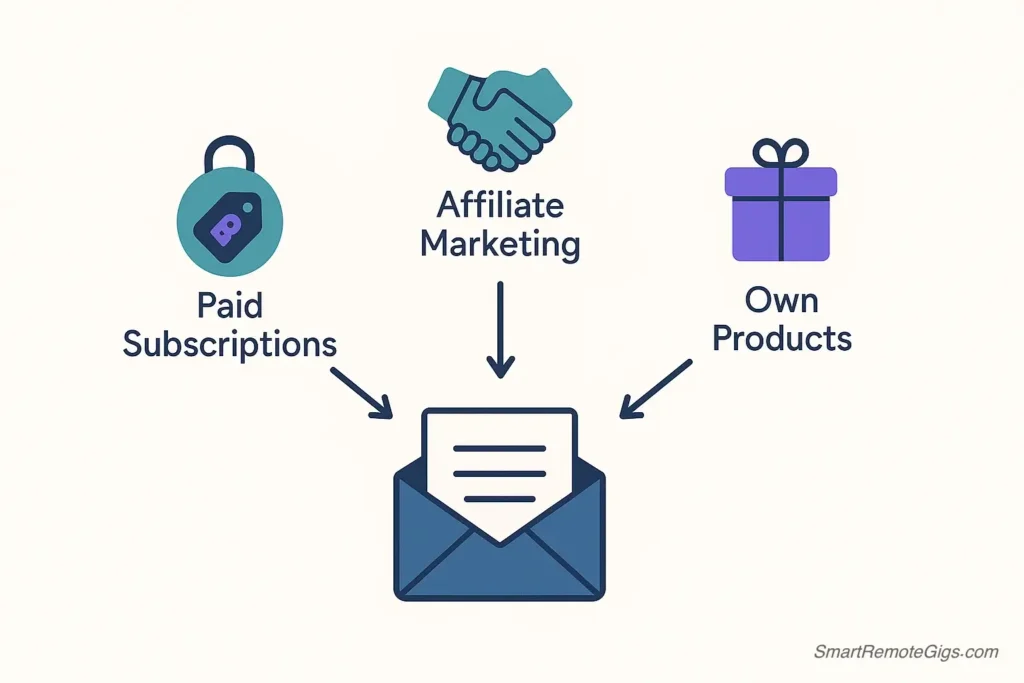
A newsletter isn’t just a marketing tool – it can become a significant revenue stream for your freelance business. Here are three proven monetization strategies that work particularly well when combined with other passive income strategies for freelancers.
1. Paid Subscriptions
Once you’ve built an engaged audience of 500+ subscribers, consider offering premium content. This works best when you can provide insider insights, detailed tutorials, or exclusive access that free subscribers can’t get elsewhere.
What to Include in Paid Tiers:
- In-depth case studies with actual client work
- Private community access or monthly Q&A sessions
- Exclusive resources like advanced templates or checklists
- Early access to your content or services
Pricing Strategy: Start at $5-10/month. You only need 100 paid subscribers at $10/month to generate $1,000 monthly recurring revenue.
2. Affiliate Marketing for Tools You Recommend
Recommend tools and services you genuinely use, and earn commissions when subscribers purchase through your links. This works particularly well for software tools, courses, and resources your audience needs.
Best Practices:
- Only recommend tools you actually use and love
- Be transparent about affiliate relationships
- Focus on value, not sales – explain why you recommend each tool
- Track which recommendations resonate with your audience
High-Converting Affiliate Categories for Freelancers:
- Design and productivity software
- Business and project management tools
- Educational courses in your field
- Books and resources for professional development
3. Selling Your Own Digital Products & Courses
Your newsletter is the perfect platform to launch and sell your own products. Your subscribers already trust your expertise – they’re your warmest audience.
Digital Product Ideas:
- Comprehensive course on your specialty
- Done-for-you templates and resources
- Group coaching programs
- One-on-one consultation packages
Launch Strategy: Use your newsletter to share the creation process, get feedback on ideas, and build anticipation before launch. Subscribers who watch you create something are much more likely to buy it.
Want to explore more revenue streams beyond newsletters? Our comprehensive guide on Passive Income for Freelancers: The Ultimate Guide for 2025 covers everything from digital products to affiliate marketing strategies.
Start Building Your Newsletter Empire Today
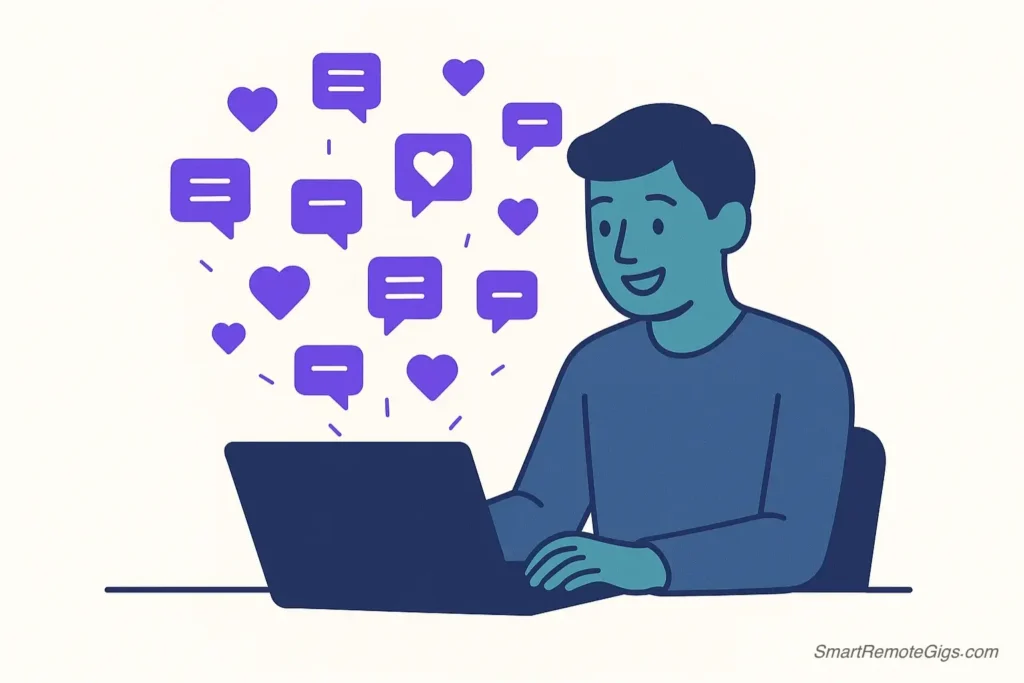
The goal isn’t perfection – it’s starting. Every successful newsletter creator began with zero subscribers and imperfect content. What separates those who succeed from those who don’t is simply beginning.
Your newsletter doesn’t need to change the world on day one. It just needs to help one person with one problem. As you consistently show up and provide value, your audience will grow, your expertise will deepen, and opportunities will compound.
Remember: social media platforms come and go, algorithms change, and trends fade. But your email list remains yours. Every subscriber is a direct connection to someone who values your expertise enough to give you space in their inbox.
Your only goal this week: Decide on your newsletter’s “one thing.” What’s the one topic you can help people with? What’s the one problem you’re uniquely positioned to solve? Start there.
The freelancers building sustainable, profitable businesses aren’t just delivering client work – they’re building their own platforms, their own audiences, and their own opportunities.
Your newsletter journey starts with a single subscriber. Make that subscriber yourself, write your first email, and hit send.
The compound effect of consistency starts now.
Frequently Asked Questions
How often should I email my newsletter list?
Start with bi-weekly emails for the best balance of consistency and sustainability. Weekly emails build stronger relationships but require more time commitment. Monthly emails are easier to maintain but slower for audience building. The key is choosing a frequency you can stick to consistently – it’s better to send bi-weekly emails reliably than weekly emails sporadically.
Is it better to use my personal name or a brand name for my newsletter?
Use your personal name if you’re building a personal brand as a freelancer. Personal names create stronger connections and trust with readers. Only use a brand name if you plan to eventually sell the newsletter or have a team writing it. Most successful freelancer newsletters use personal names because people subscribe to individuals, not faceless brands.
How many subscribers do I need before I can start monetizing?
You can start monetizing immediately with affiliate marketing and your own services. For paid subscriptions, aim for 500+ engaged subscribers before launching a premium tier. The key metric isn’t just subscriber count – it’s engagement. 100 highly engaged subscribers are more valuable than 1,000 passive ones.
What’s the best subject line strategy for newsletter emails?
Keep subject lines short (under 50 characters), specific, and curiosity-driven. Avoid spam trigger words like “free,” “urgent,” or excessive punctuation. Test personal approaches like “Quick question about your website” or benefit-focused lines like “The pricing mistake costing you clients.” Your subject line should match your email content – never use clickbait.
Should I segment my email list or send the same content to everyone?
Start with one list for your first 500 subscribers – segmentation adds complexity you don’t need early on. Once you grow larger, segment by interests, client type, or engagement level. Simple segments work best: “Active subscribers” vs “Less engaged” or “Service A interested” vs “Service B interested.”
How long should my newsletter emails be?
Aim for 300-800 words for optimal engagement. This gives you enough space to provide real value without overwhelming busy readers. Focus on one main topic per email rather than cramming multiple subjects. Your readers should be able to get value from your email in 2-3 minutes of reading.
What if I run out of things to write about?
You won’t if you focus on your audience’s problems. Keep a running list of client questions, industry challenges, and personal lessons learned. Each client interaction is potential newsletter content. Join industry forums, read comments on relevant LinkedIn posts, and survey your subscribers about their biggest challenges.
Can I repurpose my newsletter content for other platforms?
Absolutely – and you should. Turn newsletter content into LinkedIn posts, Twitter threads, YouTube videos, or blog posts. Your newsletter can be the hub that feeds all your other content channels. Just remember to give newsletter subscribers first access or bonus details to reward their subscription.
This guide provides a step-by-step roadmap to launch a newsletter that builds your freelance business and creates genuine value for your readers. Learn how to define your niche, choose a platform, create a lead magnet, and get your first 100 subscribers.
Total Time: 56 days
Define Your Niche & Goal (The “Who” and “Why”)
Before you choose a platform, get crystal clarity on who you’re serving and why they should care. Define your target audience and your newsletter’s unique value proposition.
Choose Your Platform (Substack vs. Ghost vs. ConvertKit)
Select the right platform for your needs. Substack is great for simplicity, Ghost offers more control, and ConvertKit provides advanced marketing features. For beginners, Substack is often the best choice.
Create a Simple “Lead Magnet” (A Compelling Reason to Subscribe)
Offer a valuable free resource in exchange for a subscription. This could be a checklist, template, mini-course, or resource list. Keep it simple and immediately useful.
Set Up Your Automated Welcome Email (The Most Important Email You’ll Write)
Your welcome email sets the tone. Introduce yourself, deliver the lead magnet, set expectations, provide a quick win, and invite engagement. This is your chance to make a great first impression.
Write Your First 3 “Pillar” Emails (To Deliver Immediate Value)
Before you promote your newsletter, have your first three emails ready. These should cover your core expertise and give new subscribers immediate value. Focus on solving common pain points.
Get Your First 100 Subscribers (Actionable Promotion Tactics)
Start by reaching out to your personal network. Then, use ongoing strategies like sharing valuable content on LinkedIn, participating in industry forums, and cross-promoting with other creators.
Create a Sustainable Content Calendar (How to Stay Consistent Without Burning Out)
Consistency builds trust. Choose a frequency you can stick to (weekly, bi-weekly, or monthly). Plan your content in advance, and consider batching your writing to stay ahead.
Tools:
- An email newsletter platform (e.g., Substack, Ghost, ConvertKit)
- A simple lead magnet (e.g., checklist, template)
- An automated welcome email
- A content calendar
